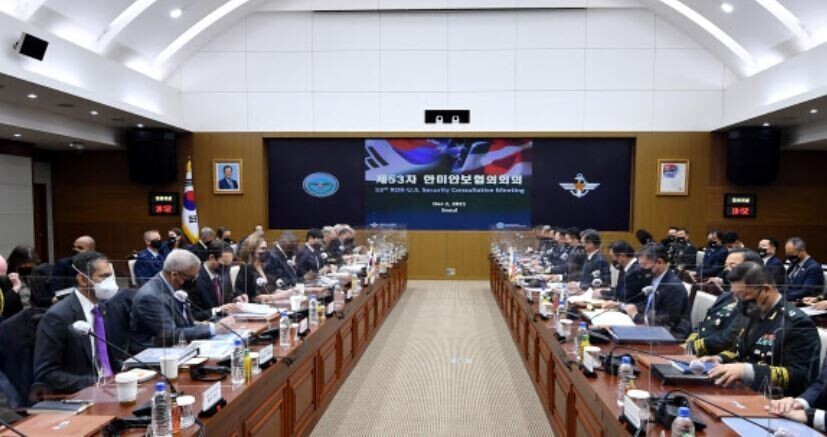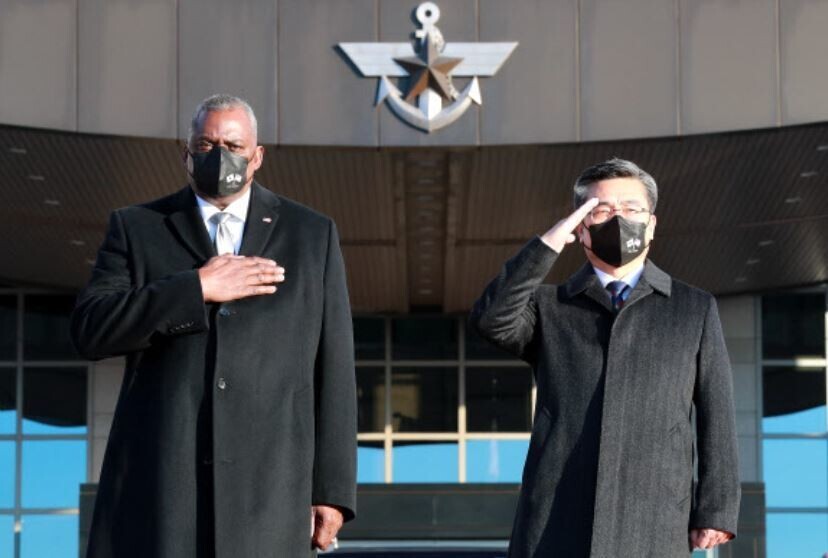hankyoreh
Links to other country sites 다른 나라 사이트 링크
S. Korea, US agree to update war plans in response to N. Korea’s newer capabilities

In a meeting on Thursday morning, Korean Defense Minister Suh Wook and US Defense Secretary Lloyd Austin agreed to update their military operational plans in response to the changing strategic situation and the growing threat of North Korea’s nuclear weapons and missiles. They promised to “strengthen the alliance’s combined deterrence posture” through what they call a “Tailored Deterrence Strategy.”
The two officials disclosed these plans in a joint communique and joint press conference following the 53rd ROK-US Security Consultative Meeting, held at South Korea’s Ministry of National Defense in Seoul’s Yongsan District.
“The Minister and the Secretary approved new Strategic Planning Guidance (SPG),” the two sides said in their joint communique. “The updated planning guidance will guide military OPLANs [operations plans] to more effectively deter — and as necessary respond to — DPRK threats to the US-ROK Alliance.” DPRK is an abbreviated form of the official name of North Korea.
The SPG represents an agreement between South Korea and the US to provide military officials from both sides with the strategic guidelines and authority needed to supplement plans for contingencies on the Korean Peninsula. The revised SPG is expected to include countermeasures against submarine-launched ballistic missiles and hypersonic missiles — two newer capabilities North Korea has been working on in the meantime.
The last time the SPG was approved was during the 42nd ROK-US Security Consultative Meeting in 2010, which led to the development of OPLAN 5015 in 2015. However, the South Korean Defense Ministry explained that a decision hasn’t been reached in the SPG deliberations about whether the OPLANs will be supplemented or rewritten.
The joint communique mentioned a “shared commitment to the complete denuclearization of and the establishment of permanent peace on the Korean Peninsula” and noted that Suh and Austin had “stressed the importance of efforts to resume diplomacy and dialogue.”
But subtle differences were evident in the points the two officials chose to emphasize on Thursday.

Austin stressed that the two sides had reconfirmed their joint assessment that North Korea’s advances in nuclear weapon and missile technology were destabilizing regional security. When asked about what impact this announcement would have on South Korea and the US resuming dialogue with North Korea and pursuing an end-of-war declaration, Suh called an end-of-war declaration a “political declaration, it’ll be difficult to say that the end-of-war declaration and the SPG have any specific relations to each other.”
In regard to the issue of transferring wartime operational control (OPCON) of allied forces on the Korean Peninsula to South Korea, the two sides agreed to carry out a full operational capability (FOC) assessment, representing the second stage in the transfer process, in the second half of 2022. That question had attracted considerable attention in Korea leading up to the meeting.
After completing the first-stage assessment for initial operational capability (IOC) in 2019, the military authorities were planning to complete the FOC assessment last week as part of their efforts to fast-track OPCON transfer. But those plans were stymied by the spread of COVID-19.
Confirmation that the FOC assessment will take place in the second half of 2022 means that President Moon Jae-in won’t be able to keep his campaign promise of wrapping up the OPCON transfer before leaving office. It’s expected to take some time for the next administration, which will take over in May 2022, to meet the requirements for the OPCON transfer, including the third-stage assessment for full mission capability (FMC).
When asked whether South Korea and the US would resume the large-scale military exercises that have been suspended since 2019, Austin said that all decisions about such exercises are made jointly by the two countries and that he and Suh “don’t have any announcements to make today.”
The joint communique specifically mentioned Taiwan and cooperation on 5G and 6G, representing the first time those issues have come up during a Strategic Consultation Meeting. Those sections of the communique reconfirmed what South Korea and the US said in the joint statement following their summit in Washington in May.
Regarding the issue of Taiwan, the statement said that Suh and Austin had “acknowledged the importance of preserving peace and stability in the Taiwan Strait, as reflected in the May 2021 Joint Statement between President Biden and President Moon.” As for cooperation on technology, the two “also pledged to seek cooperative measures in the area of 5G and next-generation mobile communications (6G).” That was in line with Moon and Biden’s agreement to “develop a future-oriented partnership” in the joint statement following their summit in May.
The Taiwan Strait is considered the geopolitical front line in the rivalry between the US and China, and 5G and 6G are areas in which the US is striving to achieve a strategic advantage in its competition for technological hegemony over China.
While the two phrases repeat what was said in the two countries’ May statement, their appearance in a joint statement following the Security Consultative Meeting — the most formal military deliberations between the two countries — could prompt a response from China or elsewhere.
“This shows that the US’ long-standing desire to create a role for South Korea [in Northeast Asia] is gradually taking on a more concrete and institutional form,” said Cheong Wook-sik, director of the Peace Network, an organization advocating for peace on the Korean Peninsula.
In connection with that, Suh declined to directly answer a reporter who asked whether South Korea would support Taiwan in the event of a Chinese attack, as Japan has recently indicated it would do.
“Our discussions were mostly focused on ways for the ROK-US alliance to respond to the North Korean threat,” Suh said. “Rather than discussing threats from specific countries, we’re continuing to explore areas for mutual cooperation between our New Southern Policy and the US’ Indo-Pacific Strategy.”
In their meeting, the two countries also agreed to finish relocating the headquarters of the ROK-US Combined Forces Command to Pyeongtaek by next year. That move is tied up with the issue of returning the Yongsan Garrison, which has long been occupied by American troops, to South Korean control.
The Security Consultative Meeting is an annual event attended by the two countries’ top defense officials. It’s held in Seoul and Washington in alternating years; last year, the meeting was hosted by the US.
By Kim Ji-eun, staff reporter
Please direct questions or comments to [english@hani.co.kr]

Editorial・opinion
![[Column] Park Geun-hye déjà vu in Yoon Suk-yeol [Column] Park Geun-hye déjà vu in Yoon Suk-yeol](https://flexible.img.hani.co.kr/flexible/normal/500/300/imgdb/original/2024/0424/651713945113788.jpg) [Column] Park Geun-hye déjà vu in Yoon Suk-yeol
[Column] Park Geun-hye déjà vu in Yoon Suk-yeol![[Editorial] New weight of N. Korea’s nuclear threats makes dialogue all the more urgent [Editorial] New weight of N. Korea’s nuclear threats makes dialogue all the more urgent](https://flexible.img.hani.co.kr/flexible/normal/500/300/imgdb/original/2024/0424/7317139454662664.jpg) [Editorial] New weight of N. Korea’s nuclear threats makes dialogue all the more urgent
[Editorial] New weight of N. Korea’s nuclear threats makes dialogue all the more urgent- [Guest essay] The real reason Korea’s new right wants to dub Rhee a founding father
- [Column] ‘Choson’: Is it time we start referring to N. Korea in its own terms?
- [Editorial] Japan’s rewriting of history with Korea has gone too far
- [Column] The president’s questionable capacity for dialogue
- [Column] Are chaebol firms just pizza pies for families to divvy up as they please?
- [Column] Has Korea, too, crossed the Rubicon on China?
- [Correspondent’s column] In Japan’s alliance with US, echoes of its past alliances with UK
- [Editorial] Does Yoon think the Korean public is wrong?
Most viewed articles
- 1‘We must say no’: Seoul defense chief on Korean, USFK involvement in hypothetical Taiwan crisis
- 2N. Korean delegation’s trip to Iran shows how Pyongyang is leveraging ties with Moscow
- 3Amnesty notes ‘erosion’ of freedom of expression in Korea in annual human rights report
- 4‘Weddingflation’ breaks the bank for Korean couples-to-be
- 5[Reportage] On US campuses, student risk arrest as they call for divestment from Israel
- 6[Column] Park Geun-hye déjà vu in Yoon Suk-yeol
- 7Korea sees more deaths than births for 52nd consecutive month in February
- 8[Editorial] New weight of N. Korea’s nuclear threats makes dialogue all the more urgent
- 9Will NewJeans end up collateral damage in internal feud at K-pop juggernaut Hybe?
- 10[Guest essay] The real reason Korea’s new right wants to dub Rhee a founding father